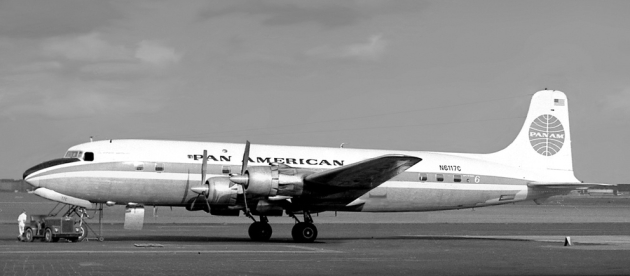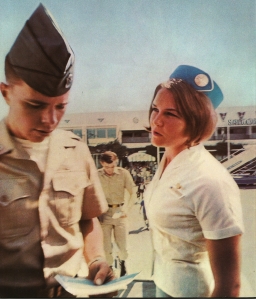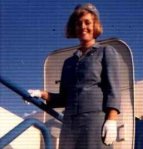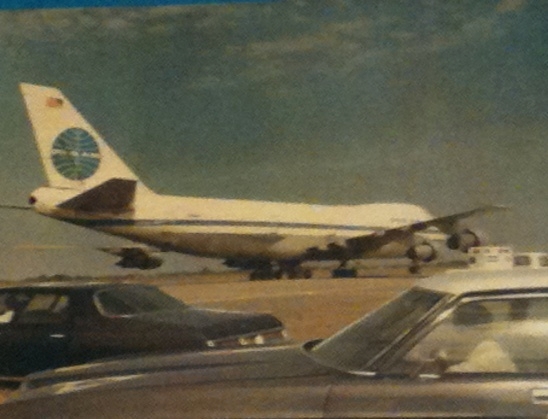Pan Am Series – Part XXXV: Saigon and R&R-2
4 May 2014 Leave a comment
Pan American in Vietnam – A Pilot’s Perspective
In the previous posts Pan American’s Vietnam involvement was presented from the perspective of a station manager, Al Topping and flight attendants, Anne Sweeney and Helen Davey. In this posting, the pilot’s perspective is chronicled through the words of former Pan American Captain John Marshall, who flew the DC-6B’s in the Rest and Recuperation airlift and also flew scheduled flights in and out of Tan Son Nhut Airport in Saigon. His story was first published in Airways Magazine and is set forth below in its entirety:
“The year was 1966. The war in Southeast Asia had been simmering, percolating just below the boil for more years than we cared to count. By 1966 enough troops and materiel had been amassed in that poor and backward corner of the Third World that it was time for the commanders to seriously look at relief for some of the longer serving units. It only made good sense that instead of rotating entire units back stateside they would be given a hiatus from the awful conditions under which they lived and fought, and the war-weary GIs would be afforded the opportunity to sample the cultural diversities of the cities of East Asia. The operation was to be called ‘R & R’, standing for Rest and Recuperation. It would require the use of enough commercial airliners to carry GIs out of Vietnam to the bright lights and flesh-pots of Asia, set them down for a week, and re turn them to the war zone to fight again. It was one of the only sensible decisions made by American commanders in that most unfortunate of wars.
“Pan American Airways at the time was in a transition of equipment from the venerable propeller-driven transports of the fifties and early sixties to the jets which would eventually take over the skies. The last hurrah for the DC-6 at Pan Am was the Internal German Service, based in Berlin, and even now that venerable airliner was rapidly being replaced in Germany by the sparkling new Boeing 727s. As the 6’s were replaced they would be headed for the backwaters of aviation; to South America and Africa, there to spend their dying years carrying livestock, heavy equipment for distant oil fields, or worse; ending up forgotten and decaying in the corner of some airplane boneyard. But wait! There was indeed one more mission, one more humanitarian task they could perform. Pan Am’s DC-6s were offered to the government under contract to carry GIs to R & R for cost plus a dollar. How could any sane government functionary refuse?
“And so it came to pass that the old Douglas’s made a slight detour on their way to pasture. They would rumble out to Hong Kong where they would form the backbone of Pan Am’s contribution to the war effort. Since the only DC-6-qualified airmen in Pan Am’s system were those in Berlin, flying out the days of the last pistons, it fell to us to man the new operation while newly-hired crews were trained and sent to Asia. We jumped at the chance to escape the dreary northern European weather and sample the exotica of Asia and the Pacific rim.

This DC-6B pictured here in Berlin was probably used initially in the Rest and Recuperation Airlift. These aircraft were brought over from the Internal German Service in Berlin. (Ralf Manteufel photo)
“After a flurry of government-mandated paperwork, mostly involving visas, inoculations and other tiresome functions , we departed in twos and threes, embarking for the long tortuous flight aboard Pan Am’s famous Flight Two, boarding at Frankfurt and finally coming to ground many sleepless hours later on another planet. We were in Hong Kong!
“After a suitable period of decompression and recovery from a first degree case of jet lag, we were ready and raring to go. The mission was deceptively simple. Battle-hardened and frazzled GIs were pulled from the war zones and sent to one of several embarkation points. Da Nang, Cam Ranh Bay, Nha Trang, and Tan Son Nhut Airport in Saigon were the most prominent. The men were loaded aboard and flown to any one of a number of Asian cities for a week’s R and R. Hong Kong, Tokyo, Taipei, and Singapore were the initial destinations; other cities were added as the program grew. Through a complex set of negotiations with the governments involved, immigration and customs formalities were kept to a minimum. Once the operation was up and running it was simply a matter of taking a load out of Vietnam, and bringing a load back. Needless to say the mood in the cabin peaked at wide extremes depending on whether the trip was headed out or back. The airline pulled out all the stops in the catering department. Kobe beef steaks, French fries, lots of cold milk and all the ice cream one could possibly eat made up the meal of choice. The flight crews dined on the same fare, but even for us such extravagant cuisine paled after a while. On about the third day of a six day trip we began to wish for chicken, or even fish — anything to break the monotony of such sumptuous gluttony.
“After a quick course in long-range operation of the airplane, we were thrown into the fray, and embarked on our first trips. None of us flight engineers had flown the airplane on a leg longer than two hours; in Europe the fuel requirements and the short flights in the ‘6 were simplicity itself. Some gas in the mains, off you go, and Bob’s your uncle. But hidden perils lurked behind the innocent conduct of a flight from Hong Kong to anywhere. Any reader who has ever had a passing acquaintance with Mr. Douglas’ piston airplanes knows what a labyrinthian maze their fuel systems could be. I learned the hard way early on.
“On a flight from Saigon to Taipei we carried fuel not only in the mains, but in the auxiliaries and reserves as well. (Ancient piston drivers, bear with me. Memory may not serve with total accuracy the nomenclature of the tanks, but you get the idea.) After top of climb we settled into the cruise routine for the long flight across the South China Sea and the Western Pacific. Mixtures were carefully leaned and spark advance set. After a bit it was time to reset the fuel panel. This was located in front of the center pedestal, behind the throttles and propeller controls. There were long levers which controlled the shutoff valves in each tank, and depending on the fuel load, there were a stupefying number of combinations with which to set the tank feed. The flight engineer (me) had to lean way over the pedestal in order to reach the controls. The captain on this trip was a laid-back old-timer who smoked a pipe (still acceptable in those days) and he leaned back in his seat and watched my efforts carefully. Tendrils of blue smoke curled gently from the smoldering briar and wafted over my shoulder. Finally satisfied, I sat back smugly.
“It wasn’t long before the skipper disengaged himself from his seat and disappeared aft. I clamored up onto his throne and settled in to enjoy the view from the best seat in the house. The sea below was a shimmering slate, and the sky ahead was dotted with puffy cumulus. How could life get any better than this? I was soon to find out.
“Half an hour passed, and the flight deck settled comfortably into the ennui of a lengthy overwater trip. The first officer was absorbed in a manual of some sort, and I gazed out the window at my side. The captain was a garrulous sort, and had not returned from the passenger cabin. Suddenly our reverie was rudely shattered by the barking cough of the number 1 engine, followed by a series of backfires in quick succession. We shot bolt upright in our seats as the number 4 quickly followed suit. I reached down and slammed the mixtures to full rich, while staring at the panel of engine instruments. The fuel pressure gauges caught my eye, primarily because the needles on the outboard engines were wildly careening around the dials. The first officer grabbed the wheel and disconnected the autopilot, at the same time exclaiming, ‘Fuel panel! Check the fuel panel!’ Startled, I reached over and slammed all the fuel valve levers to the forward position, opening all of them. After an eternity, while we gently massaged the throttles and mixtures, the outboards finally caught and resumed their healthy roar. My heart settled down to a trip-hammer rate, and I wiped beads of sweat from my brow. In a moment I was composed enough to get out the book and carefully reset the fuel feed.
“Suddenly I realized that the captain had not reappeared. I looked aft through the open cockpit door and saw him slowly sauntering forward. He stopped in the entrance and shifted the pipe from one side of his mouth to the other. He gazed at me without saying anything. ‘Little screw-up in the fuel sequencing,’ I stammered, shame-faced. I unfolded myself from his seat to let him back in.
“‘Well,’ he drawled, after he had settled himself. ‘I didn’t think it looked exactly right, but I figured you probably knew what you were doing, so I didn’t say anything.’ It was an abrupt and exciting initiation into the oceanic operation.
“I took a healthy ribbing from the flight attendant crew on our way to the hotel in Taipei. They were a venerable, uninhibited bunch, not above exploiting the chinks in the veneer of cockpit crew perfection with mirth and enjoyment. The following night the wet-behind-the-ears flight engineer was to have another adventure, although nowhere near as heart-stopping as starving two of the airplane’s four engines of fuel.
“We were the same crew, departing Taipei just at dusk for the five-hour flight to Yokota Air Base outside Tokyo. By the time we levelled off in cruise full darkness had fallen. We flew in an ocean of black, the sky above dimpled with stars that shed just enough light to outline the occasional cloud formation. After dinner the skipper again went back into the cabin to socialize, and once again I occupied the left seat. This time I had made double sure of the fuel feed sequence, and the four big Pratts rumbled along contentedly. I gazed below into the blackness, and then sat abruptly upright in the seat, heart pounding. Now I am pretty good at world geography, and I knew without really thinking that if one flew straight from Taipei to Tokyo the trip was all over water. But here we were over land, and there was a major city below us, or at least a good-sized town. Good God, we had strayed over mainland China! A curious tingling sensation began between my shoulder blades, in immediate anticipation of a barrage of .50-caliber bullets that I was sure any second would slam into the defenseless Douglas. We would fall victim to the Red Guards and the Cultural Revolution!
“I looked over at the first officer. His eyes were closed and his head nodded on his chest. “‘Clyde!’ I fairly shouted. ‘Get your charts out! Where in the hell are we?’
“Eyes opened wide in startled surprise, Clyde looked around hurriedly, straining to get his bearings. I pointed frantically downward at the thousands of lights that stretched to the horizon. Before I could say anything more, he looked over the side for a long moment, then settled wearily back in his seat. A long sigh escaped his lips. ‘Fishing fleet, John. Just fishing boats. They’re all over the ocean around here.’ In a moment his head nodded chest-ward and silence once again engulfed the cockpit.
“Operating in and out of Saigon’s Tan Son Nhut Airport was an experience unto itself. It was like no other airport in the world. While the other strips that we flew out of were primarily military bases, the airport at Saigon wore many faces. It bravely attempted to be a commercial airport like any other, with everyday airline operations trying valiantly to pretend that things were normal, coexisting with the maelstrom of military hardware fighting a war swirling around them. Even Pan American sent its 707 round-the-world flights One and Two into Tan Son Nhut on a weekly basis. Most of the time the airport made O’Hare look like a sleepy country strip. The ramp was an overwhelming place. 707s and DC-8s under military charter carried troops and materiel in and out; military C-130s from countless different squadrons and with just as many esoteric missions kept up a steady stream as they taxied to and fro, their unique rumble trembling the gut as they passed. Helicopters of every description, led by the workhorse Hueys, buzzed like malevolent insects. There were Vietnamese Air Force fighter units based there as well, flying ancient hardware that has a habit of trickling down to the Third World. Venerable C-47s and C-46s completed the mix, along with the occasional B-26.
“The airport had intersecting runways, which proved to be a mere annoyance, as operations were conducted simultaneously on both. Controllers took great pride in threading the needle at the intersection, seeing just how close they could cut it. Occasionally a flight of fighters would return with one or more of their number shot up, requiring the controllers to break out all the existing traffic until the wounded had safely landed. This resulted in a fur-ball of major proportions orbiting near the field, each pilot jockeying for position when the field re-opened. The controllers were native Vietnamese, some with limited language and/or controller skills. The sheer volume of traffic would have been daunting to an experienced journeyman, and at times the local controllers were simply overwhelmed. It was then that the down-home drawl of a GI controller would come on the mike, and laconically unravel the havoc. When things had returned to some semblance of normal (a relative term), back came the Asian controller to begin the process all over again.
“The normal entry into Tan Son Nhut used by the big transports was called a ‘Canyon Approach’. It called for the initial approach to be made at 5,000 feet above the field, an altitude safely out of range of snipers perched off the end of the runway. Once the runway had nearly disappeared under the nose, gear and full flaps went down, and the props into fine pitch. Over went the nose, pointing straight at the touchdown zone. It was a maneuver that demanded great skill and the courage to wait until the very last minute to complete. It was exciting to sit through, particularly the last few feet before the flare.
“Once safely on the ground and disembarked, Tan Son Nhut assaulted all the senses. The heat and humidity were unlike any other in Southeast Asia, and the noise and clamor and hubbub were nearly disorienting in their sheer intensity. Quickly in and quickly out was the name of the game; not only was ramp space at a precious premium, but the longer on the ground the greater exposure to dangers unknown.
“The operation lasted the better part of three years with the venerable DC-6. Eventually the new Boeing 727s and 707s took over the job, and the old Douglas finally flew into the sunset as part of Pan American’s fleet. Many ended up in Latin America and Africa, and not a few simply expired in the boneyards of the world. Their last hurrah was a stirring and exciting one, a fitting climax to the old girls’ career.”
Pan Am Captain John Marshall attended Deerfield Academy, Stanford University and served in the US Air Force in preparation for his distinguished career with Pan Am. He was based in Hong Kong, Sydney, Berlin, San Francisco and served as Chief Pilot of the Honolulu base a.k.a. “the Royal Hawaiian Flying Club”. He received the civilian Desert Shield and Desert Storm medal for flying military troops and materiel in support of Operation Desert Storm, and finished his Pan Am career commanding the last 747 revenue flight from South America-Sao Paolo to JFK. John retired as a 747 Captain with Korean Airlines. He was recently presented with the prestigious Wright Brothers “Master Pilot” Award, and is enjoying his membership with fellow Quiet Birdmen. John’s writings and columns have been published and featured for a number of years in Smithsonian Magazine and Airways Magazine, and he keeps in shape flying a WWII B-25 Bomber, “Show Me”. John presently works for the FAA as an Aviation Safety Inspector in St. Louis, MO, where he resides with his wife, Carla.
For additional information about Pan American World Airways:
To learn more about the history of this pioneering airline, click on the title below for preview of
Pan American World Airways – Images of a Great Airline Second Edition.
This book is available on eBay .
Another excellent book is Pan Am – Personal Tributes to a Global Aviation Pioneer, which was published to commemorate the 90th Anniversary of Pan Am’s founding. It contains more than 80 stories written by former Pan Am employees and international media friends who had personal experience with many of Pan Am’s key events during its history. It is the perfect companion to Pan American World Airways – Images of a Great Airline Second Edition and can be purchased on Amazon.
Preview Pan American World Airways – Aviation History Through the Words of its People, which is available on Amazon.
For further information about the history of Pan American World Airways, visit: Pan Am Historical Foundation


































Recent Comments